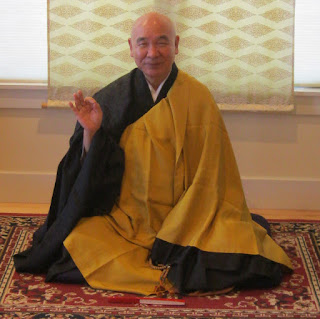Over the years of his teaching in the West, Ajari Tanaka has introduced three fundamental methods of meditation - Susoku-kan, Gaccharin-kan and Aji-kan. Collectively, these methods reflect both the basic disciplines and the richness of the Shingon tradition. It also demonstrates quite clearly Ajari Tanaka's vision for our path. Each method compliments the others and serves students in a unique way. Collectively they provide important tools to inspire personal development and at the same time build essential capacities necessary on our path. Ajari Tanaka has been incredibly generous in sharing and training us in these methods over the years. We are now grateful to be able to share them with interested students everywhere.
 |
| Ajari Tanaka brushing the syllable "KAN" |
Kanzeon translates roughly as "apprehend the world's sounds" while Kannon might be generally rendered as "apprehend the sounds". In the context of this bodhisattva, the name indicates the uninterrupted attention to the suffering of all the beings in our samsaric world. But in the context of Shingon meditations it indicates something important about the approach to meditation practice altogether.
The suffix "kan" suggest that in meditation we are seeing something worth noting. In our practice we will apprehend things worth carefully attending to. In meditation, the perceptions themselves are fuel that propels meaningful growth. The term "Kan" suggests that by using the prism of meditation method we, ourselves are worth investigating. Our own mind is worth paying close attention to. By embracing meditative discipline we will see things about ourselves that are both meaningful, enriching and profoundly transformative.
 By apprehending ourselves through meditation, unhurreid and patiently over time, utilizing the disciplines of method we can discover the things within us that are already complete, perfect and capable of making a real difference in our life and the lives of others.
By apprehending ourselves through meditation, unhurreid and patiently over time, utilizing the disciplines of method we can discover the things within us that are already complete, perfect and capable of making a real difference in our life and the lives of others.We invite students of the buddhadharma everywhere to experience the practices that Ajari Tanaka has shared in his decades of teaching in the West. Our experience is that they are unique, powerful and genuine.


